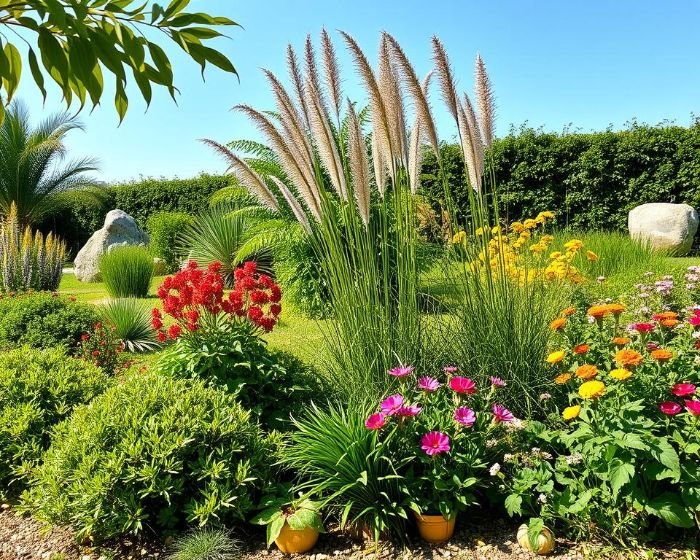Gardens in exposed sites face continuous mechanical stress from wind, which can weaken stems, strip foliage, and accelerate soil desiccation. Selecting species with traits that mitigate these effects is a strategic way to maintain plant health and landscape stability. Plants that evolved in coastal, high-altitude, or open-plain environments often display structural adaptations that allow them to endure sustained wind pressure without loss of vigor. Integrating these species into a garden plan can reduce maintenance demands and create a self-sustaining planting scheme capable of withstanding seasonal storms.
Key Takeaways:
- Wind-exposed gardens require species with specific adaptations such as flexible branching, dense canopies, and robust root anchorage.W
- Selecting plants native to windy ecosystems increases survival rates and reduces maintenance needs.
- Layered planting, combining tall windbreak trees with mid-height shrubs and ground-level cover, improves wind deflection.
- Evergreen hedges and dense shrubs serve as effective living barriers, reducing wind speed and soil moisture loss.
- Plant placement and soil reinforcement are as critical as species selection for long-term wind resilience.
Table of Contents
Selecting Plant Traits That Enhance Wind Resistance
Wind tolerance in plants is not the result of a single feature but a combination of structural and physiological adaptations. Understanding these traits allows a gardener to choose species that remain stable in high winds without constant intervention. The focus should be on characteristics that directly influence a plant’s ability to withstand mechanical stress, conserve moisture, and maintain root-to-shoot balance under pressure.
Flexible Branch Architecture
Branches that can bend without snapping are one of the most reliable defenses against storm damage. Species with supple wood fibers and layered vascular tissue can absorb wind energy by swaying rather than resisting force rigidly. Willow and tamarisk exemplify this adaptation. In practical terms, such flexibility reduces the likelihood of catastrophic limb breakage, limiting both repair work and the risk of entire plant loss after a storm.
Deep and Wide-Spreading Root Systems
A strong anchoring network underground is as important as visible above-ground structure. Plants with taproots extending deep into subsoil layers or fibrous systems that radiate laterally are far less likely to uproot. Coastal pines and certain prairie grasses thrive in wind-prone zones because their roots not only secure them in shifting soils but also access moisture reserves during prolonged dry spells. Deep rooting also helps resist soil heave caused by gusts that repeatedly loosen the top layer.
Reduced Leaf Surface Area
Large, broad leaves act like sails in heavy wind, increasing drag and physical strain on stems. Wind-adapted plants often produce narrow, needle-like, or small leathery leaves, which reduce surface resistance and moisture loss. Rosemary (Rosmarinus officinalis) and junipers are clear examples, using minimal leaf area and waxy coatings to both conserve water and reduce wind load.
Compact, Dense Growth Forms
Shorter plants with tightly packed foliage are naturally more stable because wind flows over rather than through them. Low mounding forms such as heaths and dwarf conifers present minimal vertical leverage for wind to exploit. Their density also acts as a buffer, offering protection to smaller or less wind-hardy specimens positioned behind them.
Natural Windbreak Potential
Some plants combine personal wind tolerance with the ability to shield other species. Evergreen hedges of holly or escallonia serve this dual purpose. Their year-round foliage disrupts wind currents, creating calmer microclimates for adjacent plantings. Positioning them strategically along prevailing wind lines transforms individual resilience into garden-wide protection.
A gardener who selects species with several of these traits gains more than survival; the planting scheme becomes inherently self-sustaining. By combining flexibility, strong rooting, compact form, and canopy density, it is possible to reduce structural damage, conserve water, and maintain visual appeal even through the most demanding seasons.
Tree Species Adapted to High-Wind Environments
Trees in exposed gardens face constant strain from gusts that can twist trunks, shear branches, and destabilize root systems. Selecting species that originate from naturally windy habitats like coastal cliffs, upland plains, and open savannas ensures both structural stability and long-term visual impact. Correct choice also reduces the need for staking, repeated pruning, or storm recovery work.
Coastal and Maritime Tolerant Trees
Species from coastal ecosystems often develop both wind and salt spray resistance. Their wood is dense yet flexible, and their canopies allow controlled airflow rather than acting as solid wind barriers.
| Tree Species | Notable Adaptations | Ideal Planting Context |
|---|---|---|
| Monterey Cypress (Cupressus macrocarpa) | Interlaced root system, naturally wind-shaped crown | Cliffside gardens, exposed seaside plots |
| Arbutus (Arbutus unedo) | Thick, evergreen foliage with waxy cuticle | Coastal hedgerows or mixed borders |
| New Zealand Christmas Tree (Metrosideros excelsa) | Corky bark, wind-permeable canopy | Shelter belts in maritime gardens |
These species perform best when planted in clusters or staggered lines, allowing them to mutually buffer extreme gusts.
Inland Wind-Resistant Species
Inland sites, particularly those on elevated ridges or open fields, benefit from species with deep anchoring roots and adaptable canopy forms.
- Bur Oak (Quercus macrocarpa) – Broad, heavy limbs and deep taproot make it a long-lived anchor tree in wind-prone plains.
- Rocky Mountain Juniper (Juniperus scopulorum) – Narrow profile reduces wind resistance; evergreen foliage offers year-round screening.
- Honey Locust (Gleditsia triacanthos inermis) – Open branch pattern lets wind pass through, preventing excessive mechanical strain.
Strategic Grouping for Wind Management
Single, isolated trees take the full force of prevailing winds, increasing the likelihood of failure. Planting in triangular or offset rows distributes pressure across multiple specimens and reduces turbulence at ground level. Pairing taller species with shorter, dense-canopy trees also creates a layered windbreak effect without casting excessive shade on underplantings.
Wind-adapted trees form the backbone of a resilient planting scheme. When chosen for both biological adaptations and strategic placement, they reduce wind speed across the site, protect smaller vegetation, and maintain structure without repeated corrective pruning.

Shrubs That Withstand Persistent Winds
Shrubs play a central role in a wind-resilient garden because they operate at the mid-canopy level, reducing wind speed before it reaches ground-level plants. Many also contribute year-round structure, wildlife value, and visual interest. Selecting species adapted to withstand mechanical stress, salt exposure, or soil moisture fluctuations ensures they perform reliably in exposed positions.
Evergreen Windbreak Shrubs
Evergreen species maintain their foliage year-round, which means they provide continuous protection. Their dense branching traps and slows moving air, creating sheltered microclimates for more delicate plants.
| Shrub Species | Wind-Resistant Features | Additional Landscape Value |
|---|---|---|
| Escallonia (Escallonia spp.) | Compact branching, small waxy leaves | Fragrant flowers, pollinator attraction |
| Holly (Ilex aquifolium) | Rigid leaf structure, strong central stem | Winter berries for birds |
| Elaeagnus (Elaeagnus × ebbingei) | Thick leathery foliage, fast regrowth after pruning | Silvery leaf undersides add texture |
Low-Growing Forms for Ground-Level Protection
Short, spreading shrubs reduce wind turbulence at soil level and help prevent erosion. They are particularly effective in exposed slopes, open lawns, and sandy coastal soils.
- Rugosa Rose (Rosa rugosa) – Dense thicket growth, thorny stems deter grazing wildlife, tolerant of salt-laden winds.
- Creeping Cotoneaster (Cotoneaster dammeri) – Prostrate habit, root nodes along stems anchor into soil, bright berries in autumn.
- Heather (Calluna vulgaris) – Low profile, fibrous roots stabilize sandy or acidic soils, long flowering season.
Multi-Function Hedging Options
Some shrubs combine ornamental qualities with robust wind performance, making them valuable in mixed-use plantings.
- Pyracantha (Pyracantha coccinea) – Thorned evergreen hedge, supports nesting birds, heavy berry production in autumn.
- Portuguese Laurel (Prunus lusitanica) – Tolerates shearing for formal hedges, glossy foliage resists wind burn, supports pollinators when flowering.
- Olearia (Olearia traversiorum) – Often called “daisy bush,” this New Zealand native produces dense evergreen growth and daisy-like blooms.
Shrubs positioned to intercept prevailing winds protect both structural plantings and low-growing ornamentals. By integrating evergreen windbreaks with low-profile erosion controllers, a garden gains layered defense while maintaining year-round interest.
Perennials and Ground Covers Suited for Wind-Exposed Gardens
Low-lying plant layers are vital in reducing wind impact at soil level and preventing erosion in exposed landscapes. Perennials and ground covers selected for wind-prone sites must combine strong root structures, compact growth habits, and the ability to recover quickly after weather stress. They also serve a visual function, adding texture and seasonal color to areas that might otherwise be dominated by structural windbreaks.
Perennials with Structural Stability
Perennials in windy locations must maintain upright form without splitting or lodging under gusts. Species with fibrous root systems and sturdy stems are less likely to collapse, even when repeatedly buffeted.

- Yarrow (Achillea millefolium) – Upright, resilient stems, finely divided leaves that limit wind drag, and long-lasting flower heads valuable for pollinators.
- Black-Eyed Susan (Rudbeckia hirta) – Strong stems anchored by a spreading root mass, consistent flowering through late summer, and adaptability to variable soil moisture.
- Agastache (Agastache foeniculum) – Spikes that sway without breaking, deep roots for stability, and aromatic foliage that deters browsing wildlife.
Ground Covers for Soil Anchoring
Ground-hugging plants create a living shield against wind erosion by binding topsoil with dense root mats. The best performers in exposed sites are drought-tolerant, quick to establish, and able to spread without becoming invasive.
| Ground Cover Species | Wind-Adaptive Trait | Additional Benefit |
|---|---|---|
| Creeping Thyme (Thymus serpyllum) | Low, mat-forming habit; roots at multiple nodes | Fragrant foliage, bee forage |
| Sedum (Sedum spurium) | Fleshy leaves reduce transpiration; roots stabilize poor soils | Seasonal color shifts in foliage and flowers |
| Ice Plant (Delosperma cooperi) | Succulent tissues resist dehydration under drying winds | Extended bloom period in warm months |
Combining Perennials and Ground Covers for Layered Protection
Integrating tall-stemmed perennials with fast-spreading ground covers creates a multi-tiered defense against soil loss and plant stress. Taller perennials intercept air movement, lowering velocity before it reaches the soil, while ground covers trap residual gusts and conserve moisture. This combination also reduces maintenance needs, as the living mulch from ground covers suppresses weeds around the perennial stems.

Perennials and ground covers serve more than an ornamental role in wind-exposed gardens. Their capacity to stabilize soil, reduce evaporation, and maintain form under stress makes them a critical link between structural windbreaks and the open planting areas they protect. Thoughtful pairing of species ensures year-round coverage, visual interest, and long-term site stability.
Designing a Wind-Resilient Garden Layout
The physical arrangement of plantings, structures, and open spaces can determine whether a windy site becomes a thriving landscape or a constant source of damage repair. A well-planned layout does more than block gusts – it redirects and diffuses airflow, creates sheltered microclimates, and stabilizes soil. The most effective designs combine botanical elements with structural features so that each reinforces the other.
Positioning Windbreaks for Maximum Effect
Windbreaks work by slowing and filtering air movement, not by stopping it entirely. The most reliable results come from placing them at right angles to the prevailing wind direction and spacing the plants or structures to allow some air to pass through. Solid barriers can create turbulence on the leeward side, so layered plantings with partial permeability often outperform walls or fences in terms of plant protection. Tall, deep-rooted trees or mixed hedgerows are best placed far enough from the main garden beds to reduce wind speed gradually before it reaches vulnerable species.

Layering Plant Heights to Control Airflow
A multi-tiered planting scheme transforms the garden into a living aerodynamic system. The tallest trees intercept the strongest gusts, while mid-height shrubs slow the remaining airflow. Perennials and ground covers then act as a final buffer at soil level. Each layer should overlap slightly with the next to eliminate wind gaps. For example, a staggered row of evergreens behind a mixed shrub border can protect ornamental grasses and low-flowering plants without casting excessive shade.
Integrating Hardscape Features Without Disrupting Flow
Walls, trellises, pergolas, and other hardscape structures can reinforce wind protection when positioned thoughtfully. Perforated panels, slatted fencing, or woven willow screens allow some air passage, which reduces the risk of backdrafts that can damage plants behind them. Paved pathways and low retaining walls also contribute indirectly by shaping garden zones and controlling erosion in areas where wind and rain interact. Hardscape elements should be proportionate to plantings to avoid creating rigid wind tunnels.
Managing Exposure Through Microclimate Zones
By combining windbreaks, height layering, and hardscape placement, it is possible to create microclimates where plant stress is significantly reduced. Warm, sheltered zones can host less wind-tolerant ornamentals, while exposed edges are reserved for hardy, structural species. Careful mapping of sun paths, wind direction, and seasonal gust patterns allows the garden to evolve as a balanced ecosystem rather than a patchwork of reactive fixes.
A garden that incorporates wind management into its design from the outset requires less ongoing repair and plant replacement. When plant structure, spatial arrangement, and supportive hardscape work together, the landscape can retain both its stability and visual interest through years of challenging weather.
Soil Preparation and Maintenance Practices for Wind-Exposed Gardens
Wind not only stresses plants above ground but also degrades soil conditions over time. Constant airflow accelerates moisture evaporation, compacts exposed surfaces, and erodes nutrient-rich top layers. In exposed sites, soil management must focus on anchorage, water retention, and protection against physical loss. A well-prepared soil base increases plant survival rates and reduces the need for corrective interventions after storms.
Building a Stable Soil Structure
A strong soil structure anchors root systems against lateral pull from wind. Incorporating organic matter such as composted bark, leaf mold, or well-rotted manure improves aggregation, allowing roots to penetrate more deeply. In sandy soils, added humus slows water loss and increases nutrient-holding capacity. In heavy clays, the same amendments create aeration pockets that reduce the risk of waterlogging after wind-driven rain. Deep cultivation before planting allows roots to establish quickly, which is critical for stability in the first two growing seasons.
Preventing Erosion Through Surface Protection
Bare soil in a windy environment is highly vulnerable to erosion. Permanent ground covers, whether living plants or mulches, form a protective layer that absorbs wind impact and slows surface drying. Coarse bark chips, gravel mulch, or straw reduce the scouring effect of wind at soil level. In steep or open plots, woven biodegradable mats can be laid between young plants to hold soil in place until vegetation fully covers the area.
Managing Water Retention in Drying Winds

Dry winds can deplete soil moisture even when temperatures are mild. Deep watering schedules that encourage root penetration beyond the topsoil layer are more effective than frequent shallow irrigation. Drip systems or soaker hoses placed under mulch deliver water directly to the root zone, minimizing evaporative loss. In high-evaporation regions, moisture-retentive soil amendments such as biochar or water-holding crystals can extend intervals between irrigations.
Monitoring and Seasonal Adjustment
Wind-exposed soils can change quickly in structure and nutrient profile. Regular pH testing, organic matter assessment, and compaction checks allow timely intervention. Loosening compacted areas with a broadfork or aerator restores root access to oxygen and water. Seasonal reapplication of mulch maintains coverage, while targeted top-dressing with slow-release fertilizers replenishes nutrients lost to erosion.
Soil in a windy garden is more than a planting medium – it is the foundation that holds the entire landscape together. By reinforcing structure, reducing erosion, and maintaining consistent moisture, gardeners create a stable base that supports plant health even under continuous wind pressure.
Integrating Planting and Maintenance Schedules for Long-Term Wind Resilience
Wind protection in gardens is not achieved through planting alone; it depends on the timing of establishment, the care given during early growth, and ongoing maintenance practices that adapt as the garden matures. A structured schedule allows plants to develop the strength, root depth, and canopy form necessary to endure repeated wind exposure without structural decline.

Timing Planting for Optimal Establishment
Planting in wind-exposed sites should coincide with seasons that promote rapid root development before peak wind periods. In temperate regions, early autumn often provides mild temperatures and consistent rainfall, allowing roots to anchor before winter storms. In warmer climates, late winter to early spring planting ensures young plants have a full growing season to adapt before the hottest, driest winds arrive. Avoid high-summer planting, as heat combined with wind accelerates moisture loss and reduces transplant survival rates.
Early-Stage Support and Conditioning
Newly installed plants are particularly vulnerable to uprooting or desiccation. Staking should be used only when necessary and with flexible ties that allow movement, encouraging stem strengthening rather than rigid dependence. Wind-permeable shelters, such as mesh guards or low lattice screens, can reduce stress without creating damaging turbulence. Watering should target the root zone deeply and infrequently, training roots to grow down rather than remaining shallow.
Adaptive Pruning to Manage Wind Load
As plants mature, selective pruning plays a central role in maintaining wind resistance. Removing crossing or weakly attached branches reduces the risk of breakage during storms. Thinning overly dense canopies allows wind to pass through more evenly, reducing sail effect while maintaining enough foliage for healthy growth. For hedges that function as windbreaks, trimming should maintain a profile that is broader at the base and narrower toward the top. This shape promotes even light distribution and supports dense foliage from the ground level up to the crown.
Seasonal Task Alignment
A year-round maintenance calendar prevents reactive work after damage has occurred.
- Late winter – Structural pruning before the growing season.
- Spring – Mulch replenishment and soil amendments to support vigorous growth.
- Summer – Monitoring irrigation efficiency during dry, windy spells.
- Autumn – Planting new specimens and reinforcing windbreaks ahead of winter weather.
A garden designed for wind resilience continues to evolve as plants grow and conditions shift. By aligning planting times, early-care methods, and targeted maintenance with seasonal wind patterns, the landscape gains both immediate protection and the capacity to adapt over decades without losing structural integrity.
Conclusion – Building a Garden That Thrives Under Constant Wind
A wind-resilient garden is the result of deliberate choices made at every stage, from species selection to long-term maintenance. Plants adapted to withstand mechanical stress, when positioned within a layered and strategically planned layout, transform exposed sites into stable, functional landscapes. Structural windbreaks, whether living or built, work most effectively when supported by soil conditions that anchor roots and retain moisture despite persistent airflow.
Maintenance is not a reactive task but a continuous process of refinement. Timely pruning, soil protection measures, and seasonal adjustments ensure that the garden evolves in strength rather than degrades under repeated stress. The combination of deep-rooted trees, protective shrubs, and ground-level plantings forms a living system where each layer shields the next, creating microclimates that support both resilience and biodiversity.
When design, horticultural knowledge, and consistent care align, a windy site can shift from a challenging environment to a productive, enduring landscape. The investment in planning and execution pays back over years, delivering stability, reduced upkeep, and a garden that holds its form and vitality through every season.
FAQ
How can I determine the prevailing wind direction in my garden before planning wind-resistant plantings?
Monitoring wind patterns over time is the most accurate approach. Keep a garden log for at least one full season, noting wind direction and intensity on different days. Visual cues such as consistent leaning of nearby trees or patterns in snow drift and dust accumulation can also reveal dominant wind flows.
Are there specific soil amendments that improve wind resilience in plants beyond standard compost?
In addition to organic compost, incorporating mineral amendments like coarse sand for drainage or biochar for water retention can increase plant stability in windy sites. Biochar improves soil porosity and nutrient retention, supporting root strength. For sandy soils, clay-rich topsoil blends can help anchor roots by increasing cohesion without reducing drainage.
How can I prevent windburn on evergreen foliage in exposed gardens?
Windburn is often caused by excessive transpiration during cold or dry conditions. Applying an anti-desiccant spray in late autumn can reduce moisture loss in evergreen leaves. Ensuring plants are well-hydrated before freezing conditions arrive also helps. In severe locations, installing temporary wind-permeable screens during winter months can prevent prolonged exposure to desiccating winds.
What planting distance is optimal for creating an effective living windbreak?
The distance depends on species growth habit, but generally, spacing plants at two-thirds of their mature canopy width creates a dense barrier without overcrowding. For multi-row windbreaks, stagger the planting so gaps in one row are covered by plants in the next, increasing overall wind filtration.
How can I integrate ornamental plants that are not naturally wind-resistant into an exposed site?
Place them in sheltered microclimates created by taller wind-tolerant species or structures. For example, situating delicate perennials on the leeward side of dense evergreen hedges or behind a permeable fence reduces direct wind exposure. Raised beds with windward barriers can also buffer vulnerable plants while improving drainage.
What is the most effective way to reduce soil erosion caused by wind in a sloped garden?
Combining terracing with permanent ground cover offers the highest level of protection. Terracing reduces slope length, slowing wind-driven soil movement. Deep-rooted ground covers such as creeping thyme or low junipers bind the soil, while mulch between plantings prevents bare patches where erosion can begin.
Do coastal and inland windbreak plants require different maintenance routines?
Yes. Coastal species often face salt spray in addition to wind, requiring occasional freshwater rinsing of foliage to prevent salt buildup. Inland species in dry climates may need supplemental irrigation during prolonged windy periods to counter accelerated evaporation. Both benefit from regular pruning to maintain density and structural integrity.
How soon after planting will a new windbreak start offering protection?
Protection begins as soon as plants establish roots and produce consistent foliage coverage, typically within two to three growing seasons for fast-growing shrubs. For slower species, interplanting with quick-growing nurse plants can provide interim shelter while the primary windbreak matures.










